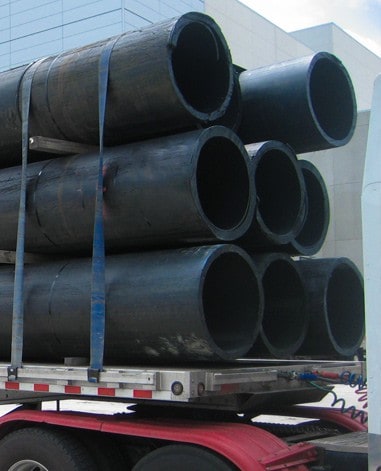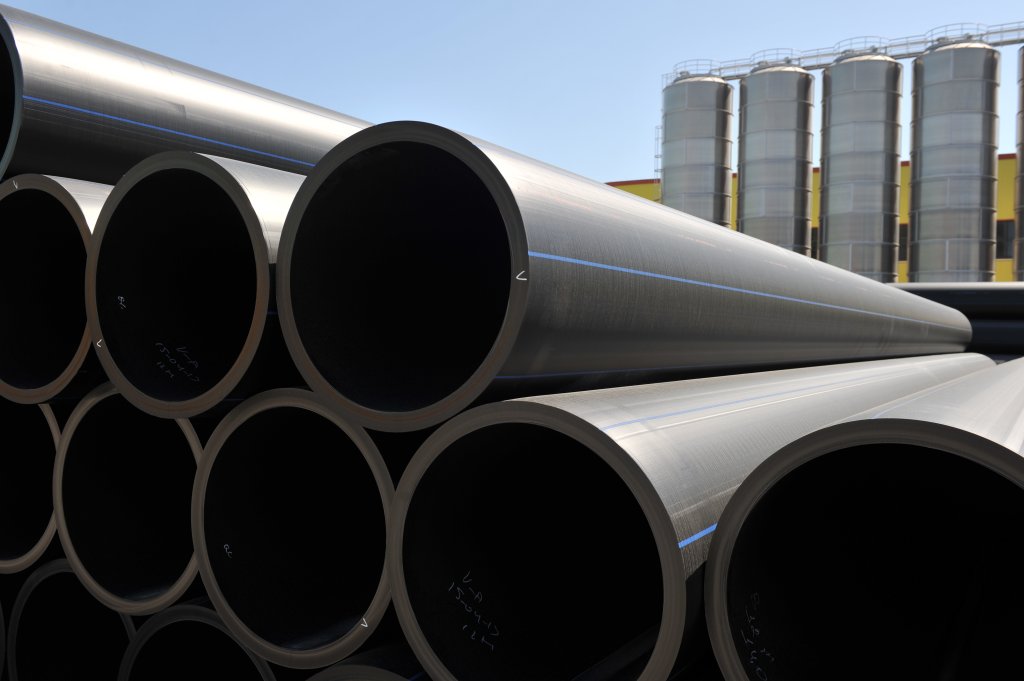How American Plastics HDPE Pipe for Oilfield Supports Oilfield Operations
Check Out the Manufacturing Process Behind High-Quality HDPE Pipeline and Its Applications
The manufacturing procedure of high-quality HDPE pipelines is elaborate and methodical. It begins with the selection of basic materials that enhance performance. Following this, ethylene goes through polymerization to develop material, which is then formed via extrusion. Quality assurance is critical, guaranteeing that the last item satisfies strict criteria. The journey of HDPE pipes doesn't finish with manufacturing. Their applications across numerous industries reveal a wider significance worth taking a look at.
Understanding HDPE: Features and Advantages

High-density polyethylene (HDPE) is a versatile polycarbonate recognized for its durability and resistance to numerous environmental factors. This product exhibits superb tensile stamina, making it appropriate for demanding applications. Its low-density framework adds to a lightweight item, promoting ease of managing and installation. HDPE also showcases exceptional resistance to chemicals, which decreases degradation when exposed to harsh compounds.
The product's low moisture absorption additionally improves its longevity, making it suitable for use in pipelines and tank. Furthermore, HDPE is resistant to ultraviolet (UV) radiation, making certain that products maintain their honesty even when exposed to sunlight. Additionally, its adaptability permits the production of complex shapes without endangering stamina. The environment-friendly nature of HDPE, often stemmed from recycled materials, contributes to its allure, promoting sustainable practices in manufacturing. Overall, these residential or commercial properties and benefits make HDPE a preferred selection for different commercial and customer applications.
Basic Material Selection for HDPE Production
The selection of raw products for HDPE production is important to validate the end product satisfies the wanted requirements and high quality criteria. High-density polyethylene (HDPE) is mainly produced from polymerized ethylene, originated from fossil fuels such as natural gas or petroleum. The high quality of these feedstocks substantially influences the mechanical and thermal properties of the final HDPE.
Additives additionally play a significant duty in boosting HDPE's efficiency, consisting of antioxidants, UV stabilizers, and colorants, which boost toughness and resistance to ecological variables. The selection process should consider not only the chemical composition of the raw materials yet additionally their handling qualities to ensure reliable manufacturing.
The sourcing of raw products need to prioritize sustainability and conformity with environmental policies, as responsible methods are critical in today's market. Eventually, mindful basic material choice lays the foundation for generating top notch HDPE pipes appropriate for varied applications.
The Extrusion Process: Shaping HDPE Pipe
The extrusion procedure plays a vital function fit HDPE pipelines, beginning with meticulous product prep work methods that ensure ideal flow and uniformity. Equally crucial is the layout of the die, which straight influences the final measurements and surface top quality of the pipeline. With each other, these factors add significantly to the performance and quality of HDPE pipeline manufacturing.
Material Prep Work Techniques
Reliable manufacturing of HDPE pipes begins with meticulous product preparation strategies, specifically the extrusion process. Throughout this phase, high-density polyethylene resin is initial dried to get rid of dampness, guaranteeing perfect flow attributes. The material is then fed right into the extruder, where it undergoes home heating and melting, transforming into a thick state. This heating process is thoroughly regulated to preserve the product's honesty and efficiency. The molten HDPE is forced with a die, shaping it right into a continual pipeline kind. Correct temperature level monitoring throughout extrusion is vital, as it directly affects the material's homes and the end product top quality. When formed, the HDPE pipe is cooled and cut to specified lengths, all set for succeeding processing and applications.
Die Design Importance
Accuracy in die style plays a necessary function in the extrusion process of HDPE pipelines. The die works as the final shaping tool, straight influencing the pipeline's dimensions, wall density, and surface coating. A properly designed die guarantees uniform product circulation, reducing issues such as abnormalities and weak areas. The geometry of the die should be maximized to fit the details properties of HDPE, including its thickness and thermal behavior throughout extrusion. Additionally, the cooling price of the material as it travels through the die can considerably influence the pipeline's structural honesty. Spending in advanced die modern technology is vital for makers intending to generate high-quality HDPE pipelines that fulfill industry requirements and consumer expectations.
Quality Assurance Steps in HDPE Manufacturing
Different variables affect the high quality of HDPE pipeline production, reliable quality control steps are important to assure consistency and reliability in the final product (hdpe pipe in stock Midland TX). Trick quality control practices include rigorous product evaluation, verifying that the raw polyethylene satisfies well established criteria for pureness and thickness. Throughout the extrusion process, criteria such as temperature, stress, and cooling time are closely kept track of to preserve dimensional accuracy and architectural integrity
Furthermore, post-production screening is important; producers frequently conduct hydrostatic examinations to evaluate the pipeline's toughness and resistance to stress. Visual examinations for surface area issues even more boost top quality assurance. Qualification from relevant criteria companies, like ASTM or ISO, gives an additional layer of integrity. By implementing these comprehensive quality assurance actions, manufacturers can lessen flaws, boost performance, and guarantee that the HDPE pipelines meet the certain requirements of different applications, inevitably leading to client satisfaction and count on the item.
Applications of HDPE Pipeline Throughout Industries
HDPE pipes are made use of across numerous industries as a result of their durability and convenience. In water distribution systems, they assure efficient delivery, while in wastewater management, they supply dependable options for waste transport. Furthermore, farming irrigation networks take advantage of HDPE's resistance to deterioration and versatility, making it an ideal option for modern farming methods.

Water Circulation Equipments
A considerable number of industries rely upon high-density polyethylene (HDPE) pipelines for effective water distribution systems. Known for their resilience and resistance to deterioration, HDPE pipelines are widely used in municipal water networks, farming watering, and industrial applications. Their lightweight nature helps with easy handling and installation, reducing labor costs and time. Furthermore, HDPE pipelines can accommodate various stress levels, making them ideal for both low and high-pressure systems. hdpe pipe suppliers Midland TX. The flexibility of the material enables seamless integration right into existing facilities, decreasing the need for substantial excavation. HDPE's resistance to chemical leaching guarantees that the water provided stays risk-free and tidy, making it an excellent choice for preserving the high quality of drinkable water across various industries.
Wastewater Administration Solutions
Efficient water distribution systems likewise lead the way for innovative wastewater administration remedies, where high-density polyethylene (HDPE) pipelines play a substantial function. Popular for their longevity and resistance to corrosion, HDPE pipelines are excellent for moving wastewater in different settings. Their flexibility enables easy setup in intricate atmospheres, minimizing the need for extensive excavation. In addition, HDPE's smooth interior surface reduces rubbing, improving flow prices and effectiveness. These pipes are additionally immune to chemical leaching, guaranteeing that contaminants do not endanger the surrounding environment. Industries, municipalities, and therapy centers increasingly rely upon HDPE pipes for their integrity and durability, making them a favored choice for modern-day wastewater administration systems. This flexibility highlights the critical importance of HDPE pipelines across countless applications.
Agricultural Irrigation Networks
Agricultural watering networks profit significantly from making use of high-density polyethylene (HDPE) pipes, which give effective and trusted water distribution to crops. HDPE pipelines are light-weight, making them easy to transport and install, while their adaptability enables for numerous configurations in varied surfaces. These pipes demonstrate superb resistance to rust, chemicals, and UV radiation, ensuring durability in extreme agricultural environments. In addition, their smooth indoor surface reduces rubbing loss, optimizing water flow and minimizing power costs connected with pumping. The durability of HDPE pipelines, frequently surpassing half a century, contributes to reduce upkeep and substitute expenditures. Farmers progressively count on HDPE pipelines to boost watering effectiveness and advertise lasting farming techniques, inevitably leading to enhanced crop yields and resource conservation.

Future Patterns in HDPE Pipe Innovation
As the need for sustainable and effective infrastructure grows, advancements in HDPE pipe modern technology are poised to change numerous industries. Emerging fads include the combination of clever innovations, such as sensing units and IoT abilities, which facilitate real-time tracking of pipeline problems, lowering maintenance prices and avoiding leaks. In addition, the growth of advanced manufacturing strategies, such as 3D printing, is enabling the manufacturing of facility, tailored pipeline designs that deal with particular job demands.
The emphasis on recycling and round economy practices is driving the development of HDPE pipes made from recycled materials, enhancing sustainability. Enhanced jointing techniques, such as electro-fusion and mechanical installations, are likewise boosting setup performance and integrity. Lastly, the expanding focus on environmental laws is pushing manufacturers to take on greener manufacturing processes, guaranteeing that HDPE pipelines not only meet sector requirements however also cultivate a more lasting future for framework development.
Frequently Asked Concerns
Exactly How Does HDPE Compare to Various Other Plastic Materials?
HDPE exceeds numerous various other plastic products relating to sturdiness, chemical resistance, and flexibility. Its reduced thickness and high tensile stamina make it perfect for numerous applications, usually exceeding alternatives in both efficiency and durability.
What Are the Ecological Impacts of HDPE Manufacturing?
The environmental influences of HDPE production consist of greenhouse gas emissions, power usage, and possible contamination from making processes. Furthermore, improper disposal can bring about soil and water contamination, elevating worries about long-lasting eco-friendly results.
Can HDPE Pipeline Be Reused?
Yes, HDPE pipes can be reused. Numerous centers accept utilized HDPE for handling, transforming it right into new products. This reusing adds to sustainability efforts, lowering plastic waste while conserving resources get more info and power in the manufacturing cycle.
What Is the Life-span of HDPE Pipes?

Exactly How Do Temperature Level Variants Affect HDPE Pipe Performance?
Temperature variants considerably influence HDPE pipe efficiency, impacting flexibility and toughness. High temperatures can result in softening, while reduced temperatures might trigger brittleness, inevitably influencing the pipeline's durability and viability for various applications in varied environments.